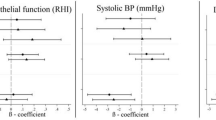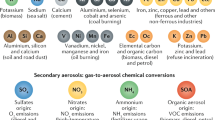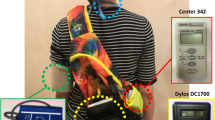Abstract
People are often exposed to traffic-related air pollution (TRAP) during physical activity (PA), but it is not clear if PA modifies the impact of TRAP on cardiac autonomic modulation. We conducted a panel study among 28 healthy adults in Barcelona, Spain to examine how PA may modify the impact of TRAP on cardiac autonomic regulation. Participants completed four 2-h exposure scenarios that included either rest or intermittent exercise in high- and low-traffic environments. Time- and frequency-domain measures of heart rate variability (HRV) were monitored during each exposure period along with continuous measures of TRAP. Linear mixed-effects models were used to estimate the impact of TRAP on HRV as well as potential effect modification by PA. Exposure to TRAP was associated with consistent decreases in HRV; however, exposure–response relationships were not always linear over the broad range of exposures. For example, each 10 μg/m3 increase in black carbon was associated with a 23% (95% CI: −31, −13) decrease in high frequency power at the low-traffic site, whereas no association was observed at the high-traffic site. PA modified the impact of TRAP on HRV at the high-traffic site and tended to weaken inverse associations with measures reflecting parasympathetic modulation (P≤0.001). Evidence of effect modification at the low-traffic site was less consistent. The strength and direction of the relationship between TRAP and HRV may vary across exposure gradients. PA may modify the impact of TRAP on HRV, particularly at higher concentrations.
This is a preview of subscription content, access via your institution
Access options
Subscribe to this journal
Receive 6 print issues and online access
$259.00 per year
only $43.17 per issue
Buy this article
- Purchase on Springer Link
- Instant access to full article PDF
Prices may be subject to local taxes which are calculated during checkout




Similar content being viewed by others
Abbreviations
- BC:
-
black carbon
- BMI:
-
body mass index
- BP:
-
blood pressure
- b.p.m.:
-
beats per minute
- HF:
-
high frequency power
- HR:
-
heart rate
- HRV:
-
heart rate variability
- LAeq:
-
A-weighted decibels (dB) of sound pressure
- LF:
-
low frequency power
- LF:HF:
-
ratio of low to high frequency power
- NO:
-
nitrogen oxide
- NO2:
-
nitrogen dioxide
- NOX:
-
nitrogen oxides
- PM2.5:
-
particulate matter ≤2.5 μm (fine)
- RMSSD:
-
root mean square of successive differences in adjacent NN intervals
- SDNN:
-
standard deviation of normal to normal intervals
- TRAP:
-
traffic-related air pollution
- UFP:
-
ultrafine particle.
References
Weichenthal S . Selected physiological effects of ultrafine particles in acute cardiovascular morbidity. Environ Res 2012; 115: 26–36.
Pope CA, Verrier RL, Lovett EG, Larson a C, Raizenne ME, Kanner RE et al. Heart rate variability associated with particulate air pollution. Am Heart J 1999; 138 (Pt 1): 890–899.
Pieters N, Plusquin M, Cox B, Kicinski M, Vangronsveld J, Nawrot TS . An epidemiological appraisal of the association between heart rate variability and particulate air pollution: a meta-analysis. Heart 2012; 98: 1127–1135.
Weichenthal S, Kulka R, Dubeau A, Martin C, Wang D, Dales R . Traffic-related air pollution and acute changes in heart rate variability and respiratory function in urban cyclists. Environ Health Perspect 2011; 119: 1373–1378.
Weichenthal S, Hatzopoulou M, Goldberg MS . Exposure to traffic-related air pollution during physical activity and acute changes in blood pressure, autonomic and micro-vascular function in women: a cross-over study. Part Fibre Toxicol 2014; 11: 70.
De Hartog J, Boogaard H, Nijland H, Hoek G . Do the health benefits of cycling outweigh the risks? Environ Health Perspect 2010; 118: 1109–1116.
Rojas-Rueda D, de Nazelle A, Tainio M, Nieuwenhuijsen MJ . The health risks and benefits of cycling in urban environments compared with car use: health impact assessment study. BMJ 2011; 343: d4521.
Andersen ZJ, de Nazelle A, Mendez MA, Garcia-Aymerich J, Hertel O, Tjønneland A et al. A study of the combined effects of physical activity and air pollution on mortality in elderly urban residents: the Danish Diet, Cancer, and Health Cohort. Environ Health Perspect 2015; 123: 557–563.
Ajuntament de Barcelona. Barcelona Data Sheet. Generalitat de Catalunya: Barcelona, Spain, 2012. Available from http://w42.bcn.cat/web/en/media-room/.
Gulati M, Shaw LJ, Thisted RA, Black HR, Bairey Merz CN, Arnsdorf MF . Heart rate response to exercise stress testing in asymptomatic women: the St. James Women Take Heart Project. Circulation 2010; 122: 130–137.
Huang J, Deng F, Wu S, Lu H, Hao Y, Guo X . The impacts of short-term exposure to noise and traffic-related air pollution on heart rate variability in young healthy adults. J Expo Sci Environ Epidemiol 2013; 23: 559–564.
Wu S, Deng F, Niu J, Huang Q, Liu Y, Guo X . The relationship between traffic-related air pollutants and cardiac autonomic function in a panel of healthy adults: a further analysis with existing data. Inhal Toxicol 2011; 23: 289–303.
Hemmingsen JG, Rissler J, Lykkesfeldt J, Sallsten G, Kristiansen J, PM P et al. Controlled exposure to particulate matter from urban street air is associated with decreased vasodilation and heart rate variability in overweight and older adults. Part Fibre Toxicol 2015; 12: 6.
Timonen KL, Vanninen E, de Hartog J, Ibald-Mulli A, Brunekreef B, Gold DR et al. Effects of ultrafine and fine particulate and gaseous air pollution on cardiac autonomic control in subjects with coronary artery disease: the ULTRA study. J Expo Sci Environ Epidemiol 2006; 16: 332–341.
Riediker M, Cascio WE, Griggs TR, Herbst MC, Bromberg PA, Neas L et al. Particulate matter exposure in cars is associated with cardiovascular effects in healthy young men. Am J Respir Crit Care Med 2004; 169: 934–940.
Huang Y-CT, Rappold AG, Graff DW, Ghio AJ, Devlin RB . Synergistic effects of exposure to concentrated ambient fine pollution particles and nitrogen dioxide in humans. Inhal Toxicol 2012; 24: 790–797.
Knibbs LD, Cole-Hunter T, Morawska L . A review of commuter exposure to ultrafine particles and its health effects. Atmos Environ 2011; 45: 2611–2622.
Daigle C, Chalupa D . Ultrafine particle deposition in humans during rest and exercise. Inhal Toxicol 2003; 15: 539–552.
Barak O, Jakovljevic D . Heart rate variability before and after cycle exercise in relation to different body positions. J Sport Sci Med 2010; 9: 176–182.
Babisch W . The noise/stress concept, risk assessment and research needs. Noise Heal 2002; 4: 1–11.
Babisch W . Exposure to Environmental Noise: Risks for Health and the Environment. Workshop on “Sound Level of Motor Vehicles”. Directorate-General for Internal Policies of the European Parliament: : Brussels, Belgium. 2012.
Wong C-M, Ou C-Q, Thach T-Q, Chau Y-K, Chan K-P, Ho S-Y et al. Does regular exercise protect against air pollution-associated mortality? Prev Med 2007; 44: 386–392.
Kraus U, Schneider A, Breitner S, Hampel R, Rückerl R, Pitz M et al. Individual daytime noise exposure during routine activities and heart rate variability in adults: a repeated measures study. Environ Health Perspect 2013; 121: 607–612.
Acknowledgements
We sincerely thank all participants for their assistance with data collection of the current study. This work was part of the European-wide project Transportation Air pollution and Physical ActivitieS (TAPAS): an integrated health risk assessment program of climate change and urban policies, which had partners in Barcelona, Basel, Copenhagen, Paris, Prague, and Warsaw. TAPAS was a 4-year project funded by the Coca-Cola Foundation, AGAUR, and CREAL (http://www.tapas-program.org/). CREAL is part of CIBERESP (http://www.ciberesp.es/), the Spanish Network for Epidemiology and Public Health Research. CREAL and its members are based at and supported by the Universitat Pompeu Fabra (http://www.upf.edu/en/). The funding bodies had no role in the study design, study procession, data analysis and interpretation, nor the decision to submit this paper for publication.
Author contributions
All authors contributed to the reporting of the work described in this article: TC-H, SW, MF, DM, DW, and MN guided data analyses and interpretation; NK, GC-T, AdN, and MN oversaw the planning and conduct of the work.
Author information
Authors and Affiliations
Corresponding author
Ethics declarations
Competing interests
The authors declare no conflict of interest.
Additional information
Supplementary Information accompanies the paper on the Journal of Exposure Science and Environmental Epidemiology website
Supplementary information
Rights and permissions
About this article
Cite this article
Cole-Hunter, T., Weichenthal, S., Kubesch, N. et al. Impact of traffic-related air pollution on acute changes in cardiac autonomic modulation during rest and physical activity: a cross-over study. J Expo Sci Environ Epidemiol 26, 133–140 (2016). https://doi.org/10.1038/jes.2015.66
Received:
Revised:
Accepted:
Published:
Issue Date:
DOI: https://doi.org/10.1038/jes.2015.66
Keywords
This article is cited by
-
Associations of long-term exposure to air pollution and physical activity with the risk of systemic inflammation-induced multimorbidity in Chinese adults: results from the China multi-ethnic cohort study (CMEC)
BMC Public Health (2023)
-
The Acute Effects of Exercising in Air Pollution: A Systematic Review of Randomized Controlled Trials
Sports Medicine (2022)
-
Does fine particulate matter (PM2.5) affect the benefits of habitual physical activity on lung function in adults: a longitudinal cohort study
BMC Medicine (2020)
-
Low levels of fine particulate matter increase vascular damage and reduce pulmonary function in young healthy adults
Particle and Fibre Toxicology (2020)
-
Panel study using novel sensing devices to assess associations of PM2.5 with heart rate variability and exposure sources
Journal of Exposure Science & Environmental Epidemiology (2020)



